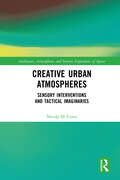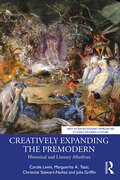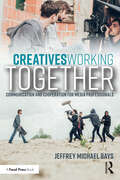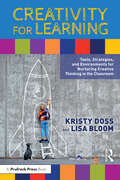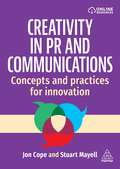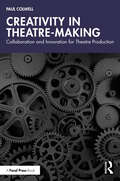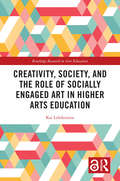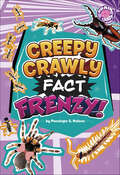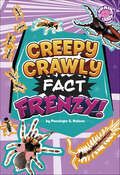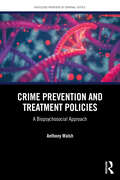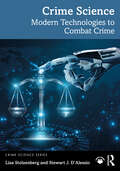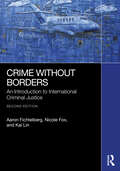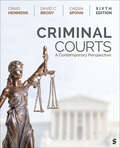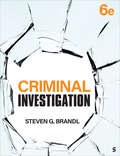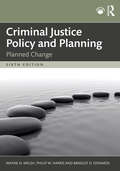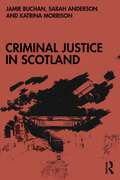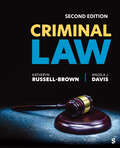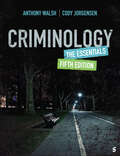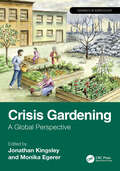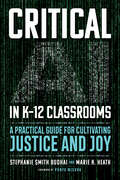- Table View
- List View
Creative Urban Atmospheres: Sensory Interventions and Tactical Imaginaries (Ambiances, Atmospheres and Sensory Experiences of Spaces)
by Nicola Di CroceCreative Urban Atmospheres explores the potential for urban planners, researchers, and artists to intervene in the atmosphere of spectacle dominating current neoliberal urbanism strategies through sensory and sound-based artistic interventions drawing from Tactical Urbanism and Research-Creation. This book equips readers with tools and insights needed to address the pressing challenges of urban livability and inclusiveness in the face of neoliberal urbanism.Through engaging discussions and a case study conducted in Montreal’s Quartier des Spectacles, the book demonstrates how sound-based and sensory interventions can reshape urban atmospheres, fostering cohabitation and inclusiveness for diverse populations. Key features include an interdisciplinary emphasis on the intertwinements of academic research, artistic practice, and participatory community engagement, ensuring that readers gain both theoretical understanding and practical approaches. With its focus on innovative methods such as Research-Creation and socially engaged art, this book not only critiques existing urban strategies but also empowers planners, artists, and communities with tactics for collaboratively transforming underused urban spaces into vibrant, livable, and inclusive social environments.This book is designed for a diverse audience deeply invested in the future of urban spaces. It will be of interest to urban planners seeking innovative approaches to address urban polarization and promote inclusiveness, as well as academic researchers in urban studies and geography exploring the intersections of Tactical Urbanism and sensory interventions. Artists, designers, and architects will find inspiration in its emphasis on creative, participatory approaches while policymakers and community advocates can draw practical insights for fostering livable, inclusive cities. It also speaks to anyone with a vested interest in the challenges facing contemporary cities, including gentrification, touristification, and neoliberal urban pressures on the most marginalized groups.
Creatively Expanding the Premodern: Historical and Literary Afterlives (New Interdisciplinary Approaches to Early Modern Culture)
by Carole Levin Christine Stewart-Nuñez Marguerite A. Tassi Julia GriffinThis book highlights the stories of women from premodern history and literature through models of adaptations, retellings, and criticism such as poems, plays, and essays. Reviving these voices from the background widens the appeal and accessibility of scholarship in the humanities.Creative composing processes draw research through the imagination and experience of the writer. This act can help explore qualities of historical events and literary figures that are still relevant today. The four authors of this book demonstrate these approaches through creative adaptations and responses to Biblical and Classical writings, Greek mythological figures, medieval narratives, powerful historical women, plays by Shakespeare, and works by other early modern English writers. What distinguishes this book from other scholarship on the premodern is its collaborative and interdisciplinary foundation, as well as its emphasis on literary and hybrid genres.Offering interdisciplinary ways of reading, thinking about, and reconceiving literature and scholarship in a way that invites dialogue and further creative responses, this volume provides humanities teachers with effective pedagogical tools to inspire deeper engagement and understanding in their students.
Creatives Working Together: Communication and Cooperation for Media Professionals
by Jeffrey Michael BaysWith this book, filmmaker Jeffrey Michael Bays utilizes a range of professional leadership experience with his background in creative collaboration to guide today’s media practitioners in getting along harmoniously.This book begins by exploring the unique personality traits that make it difficult for artists to work together, then offers solutions with expertly guided tutorials on leadership, motivation, and conflict resolution. Readers are then guided through the intimidating waters of business communication, including how to manage their inbox and send clear, effective emails. The text includes case studies featuring content on real media practitioners, ethics scenarios, writing exercises, as well as surveys and data to back up each chapter’s assessments.Providing a framework for success in today’s media businesses, this book will be an integral reference guide for creative professionals and students who want to gain leadership skills, resolve conflicts, and maximize the efficiency of the creative teams they work in.
Creativity for Learning: Tools, Strategies, and Environments for Nurturing Creative Thinking in the Classroom
by Lisa Bloom Kristy DossCreativity for Learning provides a comprehensive understanding of creativity's role in learning, as well as practical approaches to teaching creative thinking strategies to diverse learners.This book provides a roadmap for creating instructional practices that allow learners to go beyond knowledge acquisition. Chapters provide research on creativity along with insights from professionals who apply creativity in their work, offering valuable guidance on how to nurture these essential skills in the classroom. Packed with research-based activities to help learners acquire and exercise creative thinking, novel approaches to assessment, as well as suggestions for learning space design, this book has everything you need to orchestrate a classroom that fosters equitable talent development for all students across the content areas.This must-read guide will be the trusted companion for all educators seeking to transform their students into creative thinkers ready to meet the challenges of an uncertain future.
Creativity in PR and Communications: Concepts and Practices for Innovation
by Jon Cope Stuart MayellBeing creative is a key component and necessity in public relations and within creative industries to target business challenges, create briefs and to meet targets.Creativity in PR and Communications is a textbook for all PR students and anyone taking creative communication courses looking to enhance their understanding of the creative process. It explores:- Fostering a creative mindset- Cultivating creativity- Creative thinking- Creative ideation processes- AI as a tool to assist creativity- Using creativity to enhance briefs and campaigns With this textbook, students are provided with the practical insights, theories and models needed to become more creative and use that creativity towards PR and communications-related business challenges. It also illustrates how students can become more creative practitioners for the workplace, through research, theory and practical insights.Learn how to nurture creative ideas and when to let go of weaker ones with this public relations textbook, illustrating the strategic processes of creativity and how to apply them to PR problems.This book is full of real-world examples from global companies such as Unilever, Marmite, Marc Jacobs, Spotify and Heinz, and is supported by a range of key features to illustrate how to implement creative industry practices. These key features include a glossary, practical insights, learning outcomes and exercise questions. Online resources include PowerPoint slides for lecturers and additional best and creative practice examples.
Creativity in Theatre-Making: Collaboration and Innovation for Theatre Production
by Paul ColwellCreativity in Theatre-Making identifies and explores relationships between theatremakers. The book seeks to expand opportunities for creativity and collaboration from concept to realisation. It does so by reconsidering the so-called ‘technical roles’ as ‘creators’, thereby dismantling the conventional distinction between creative and technical teams. The book challenges this limited views of creativity, offers an alternative model of relationships – a heterarchy – and uses this to underpin a range of techniques and strategies that improve the productivity, well-being, and inclusivity of professional theatre practice. Its core pedagogic principle is that understanding ‘why’ is more useful than simply knowing ‘what’. The book includes an overview of all the major specialist meetings and roles in theatre-making; as well as an in-depth exploration of the key resources used to create Shows and how these can be utilised collaboratively and sustainably. There is also advice on giving and receiving effective feedback during the production process and engaging with creative, financial and safety risks. Throughout the text, the author defines the specialist terminology being used, and offers real-world examples. Creativity in Theatre-Making is for undergraduate and postgraduate students studying for a creative and/or ‘technical’ role in the theatre industry and related sectors, as well as early- and mid-career theatre professionals looking to appraise or refresh their practice.
Creativity, Society, and the Role of Socially Engaged Art in Higher Arts Education (Routledge Research in Arts Education)
by Kai LehikoinenThis interdisciplinary book explores socially engaged art as a subject of study and its relevance in higher arts education institutions' third mission—giving back to society and engaging with the community—to build a sustainable higher arts education for the future.Drawing on data from two large-scale EU-funded projects—supplemented by interviews, educational document analysis, and secondary data—this book explores emerging trends in the arts sector and the role of arts universities in cross-sector collaboration, innovation, and actions towards social and environmental responsibility. Chapters posit theoretical analysis, case studies and practically orientated examples from countries including the United States, Ghana, Indonesia, and from across Europe to explore the growing demands for the positive societal impact of higher arts education. Located at the interface between the sociology of higher arts education and community engagement, the book explores a richness of international contexts including activism, churches, refugee work, eldercare, gender politics, prisons and many others.This timely volume responds to the urgent need to investigate the full potential of socially engaged art in higher arts education. As such, it will appeal foremost to scholars, researchers, postgraduate students, and teachers in higher arts education and the sociology of education. Practitioners working in arts curriculum design, university-society partnerships, and those focused on creating inclusive and respectful spaces in higher arts education and research, will also find the volume of use.
Creepy Crawly Fact Frenzy!
by Penelope S. NelsonThere’s a CREEPY CRAWLY FACT FRENZY headed your way! Did you know the Goliath birdeater spider can grow to be a foot long? Or that a dragonfly can fly 20 miles per hour? Dozens of bite-size creepy crawly facts are paired with surprising bug photos, welcoming in even the most reluctant readers. Whether kids are in the mood to browse or to devour a book from cover to cover, even a dedicated fan of all things creepy crawly is sure to learn something surprising as they flip through these pages.
Creepy Crawly Fact Frenzy! (Fact Frenzy)
by Penelope S. NelsonThere&’s a CREEPY CRAWLY FACT FRENZY headed your way! Did you know the Goliath birdeater spider can grow to be a foot long? Or that a dragonfly can fly 20 miles per hour? Dozens of bite-size creepy crawly facts are paired with surprising bug photos, welcoming in even the most reluctant readers. Whether kids are in the mood to browse or to devour a book from cover to cover, even a dedicated fan of all things creepy crawly is sure to learn something surprising as they flip through these pages.
Creepy Crawly Fact Frenzy! (Fact Frenzy)
by Penelope S. NelsonThere&’s a CREEPY CRAWLY FACT FRENZY headed your way! Did you know the Goliath birdeater spider can grow to be a foot long? Or that a dragonfly can fly 20 miles per hour? Dozens of bite-size creepy crawly facts are paired with surprising bug photos, welcoming in even the most reluctant readers. Whether kids are in the mood to browse or to devour a book from cover to cover, even a dedicated fan of all things creepy crawly is sure to learn something surprising as they flip through these pages.
Crime Prevention and Treatment Policies: A Biopsychosocial Approach (Routledge Frontiers of Criminal Justice)
by Anthony WalshThis book shows how to use biopsychosocial assessment for crime prevention and to achieve more individualized treatment for those who commit crimes. Author Anthony Walsh, a prominent figure in biosocial criminology for more than four decades, examines the treatment policy recommendations of major criminological theories and how they might be improved by integrating relevant biopsychosocial insights. Walsh contends that sound crime prevention and treatment policies must be based on empirical evidence derived from theories about the causes of crime if they are to reduce incarceration rates. The biopsychosocial perspective improves on traditional theories by examining all putative causes of crime from the micro to the macro— from neurons to neighborhoods— and should thus improve prevention and treatment efforts.The understanding of the genetic, neurobiological, and physiological components of antisocial behavior has improved exponentially over the past three decades. The relevant biological measures (e.g., genotyping, hormone assays, autonomic system arousal levels, resting heart rates) are routinely examined in university labs for research purposes. This book shows how measures of these components can be fruitfully integrated into the risk- need- responsivity model of offender treatment.Offering a fresh perspective, this book is essential for both scholars and practitioners wishing to explore treatment modalities that consider the biological aspects of criminality.
Crime Science: Modern Technologies to Combat Crime (Crime Science Series)
by Lisa Stolzenberg Stewart J. D'AlessioThis book comprehensively examines the rapidly changing tactics and technologies used to combat crime. The authors delve into the intricacies of how scientific methodologies and technological advancements are employed to investigate and prevent various forms of crime, exploring topics such as forensic science, cybercrime, data analytics, crime mapping, predictive policing, and other technological and scientific advancements that aid law enforcement and criminologists in their work. It explores the interplay between criminology, technology, and science and arms readers with knowledge about cutting-edge techniques and technologies utilized in the fight against crime. Through engaging narratives, case studies, and expert insights, this book sheds light on the intricate web of scientific disciplines that play a pivotal role in uncovering and solving crimes. The technologies covered represent a complex web of tools available to law enforcement and other criminal justice agencies. However, it is important to recognize that integrating these technologies requires careful consideration of legal, ethical, and social issues, including privacy rights and potential biases in predictive algorithms. As technology continues to evolve, so will the tools available for crime prevention, detection, and prosecution. It is an ongoing process of balance and adjustment as society seeks to ensure safety and justice while preserving individual rights and freedoms. Appropriate as a textbook for crime science, criminal investigation, and crime prevention courses in criminology and criminal justice programs, Crime Science: Modern Technologies to Combat Crime is also useful for professionals and others intrigued by the world of crime and investigation. This book is a groundbreaking exploration into the important role science plays in comprehending, preventing, and solving crimes in the modern era.
Crime Without Borders: An Introduction to International Criminal Justice
by Aaron Fichtelberg Kai Lin Nicole FoxThis book introduces students to the challenges related to international crime and punishment and the ways that criminal justice systems have sought to confront them. The dismantling and opening up of borders by technology, transportation, international trade, and the global flow of labor and capital have allowed those engaging in criminal behavior to work across borders in ways that challenge the traditional nation-state and its criminal justice system, making the study of international crime and justice increasingly relevant. This book not only covers the nuts and bolts of international crime and law enforcement but also raises abstract, theoretical issues for debate and asks critical questions about the ideal ways to think about international criminal justice problems. Contemporary topics such as war crimes, genocide, crimes against humanity, terrorism, drug smuggling, human trafficking, financial crimes, environmental crimes, and cybercrime are addressed, and connections between globalization, politics, and criminal justice reflect the modern realities of international and transnational crime. Following an introductory chapter that presents the dimensions of international criminal justice, the text is organized into two major parts, the first part discussing major international crimes and why people engage in them, and the second part laying out the central structures of the international criminal justice system, including international courts, transnational law enforcement, and aspects of United States criminal justice developed to deal with international crimes. Throughout the book, the authors place global crime within the context of contemporary politics and current events. Pedagogical tools such as summaries of significant international cases, discussion questions, and a thorough bibliography aid reader engagement and understanding. This text is suitable for students in global criminology, international crime, and comparative criminology courses, and researchers and policy-makers concerned with international and transnational crime.
Criminal Courts: A Contemporary Perspective
by Cassia Spohn Craig T. Hemmens David C. BrodyComprehensive and engaging, Criminal Courts: A Contemporary Perspective deepens your students′ understanding by thoroughly examining the courts and their vital role in the criminal justice system. The Sixth Edition introduces updated content, including discussions on evolving marijuana laws, the balance between victims′ and defendants′ rights, court-administered bail, and domestic violence courts.
Criminal Courts: A Contemporary Perspective
by Cassia Spohn Craig T. Hemmens David C. BrodyComprehensive and engaging, Criminal Courts: A Contemporary Perspective deepens your students′ understanding by thoroughly examining the courts and their vital role in the criminal justice system. The Sixth Edition introduces updated content, including discussions on evolving marijuana laws, the balance between victims′ and defendants′ rights, court-administered bail, and domestic violence courts.
Criminal Investigation
by Steven G. BrandlCriminal Investigation, Sixth Edition offers a comprehensive and engaging examination of criminal investigation and the vital role criminal evidence plays in the process. Written in a straightforward manner, the text focuses on the five critical areas essential to understanding criminal investigations: background and contextual issues, criminal evidence, legal procedures, evidence collection procedures, and forensic science. In this brand new edition, author Steven G. Brandl goes beyond a simple how-to on investigative procedures, and draws from fascinating modern research, comprehensive cases, and criminal evidence to demonstrate their importance in the real world of criminal justice, providing students with practical insights into the field of criminal investigation.
Criminal Investigation
by Steven G. BrandlCriminal Investigation, Sixth Edition offers a comprehensive and engaging examination of criminal investigation and the vital role criminal evidence plays in the process. Written in a straightforward manner, the text focuses on the five critical areas essential to understanding criminal investigations: background and contextual issues, criminal evidence, legal procedures, evidence collection procedures, and forensic science. In this brand new edition, author Steven G. Brandl goes beyond a simple how-to on investigative procedures, and draws from fascinating modern research, comprehensive cases, and criminal evidence to demonstrate their importance in the real world of criminal justice, providing students with practical insights into the field of criminal investigation.
Criminal Justice Policy and Planning: Planned Change
by Philip W. Harris Wayne N. Welsh Bradley D. EdwardsUnlike other textbooks on the subject, this book presents a comprehensive and structured account of the process of administering planned change in the criminal justice system. The authors detail a simple yet sophisticated seven-stage model, which offers students and practitioners a full account of program and policy development from beginning to end. Within these stages, students focus on performing essential procedures, such as conducting a systems analysis, specifying an impact model, identifying target populations, making cost projections, collecting monitoring data, and performing evaluations. In reviewing these steps and procedures, students can develop a full appreciation for the challenges inherent in the process and understand the tools they require to meet those challenges. To provide for a greater understanding of the material, the text uses a wide array of real-life case studies and examples of programs and policies. By examining the successes and failures of various innovations, the authors demonstrate both the ability of rational planning to make successful improvements and the tendency of unplanned change to result in undesirable outcomes. The result is a powerful argument for the use of logic, deliberation, and collaboration in criminal justice innovations.This readable volume is ideal as a primary or supplemental text in criminal justice policy-related courses, and also serves as a useful reference for practitioners in the field tasked with strategic planning for policy change.
Criminal Justice in Scotland
by Jamie Buchan Sarah Anderson Katrina MorrisonProviding a comprehensive and up-to-date introduction to the contemporary Scottish criminal justice system, this book focuses on its key processes (from arrest to post-sentence) and institutions, as well as its history and some of the key challenges and critical issues facing Scottish criminal justice today.Highly attentive to procedural and institutional detail, this book is underpinned by a critical sociological perspective. The opening chapter considers Scotland in its post-devolutionary context within the UK, setting the scene for Scottish criminal justice institutions. Subsequent chapters deal in turn with different institutions and processes of Scottish criminal justice: surveillance and crime prevention, policing, prosecution and the courts, criminal fines and other financial penalties, community justice, electronic monitoring, prisons, youth justice, and parole and post-sentence reintegration and supervision. The final chapter draws on comparative and international criminology to look at Scottish criminal justice in changing international contexts and its response to new global crimes.Designed to support learning, it includes the following: Key ideas at the start of each chapter, outlining expectations and providing a very high-level summary of the most important points Text boxes covering key issues, controversies and/or key populations in focus Critical questions to challenge students to develop their own thinking and ideas about key issues in Scottish criminal justice Short, informal interviews with key practitioners and researchers Essential readings and key resources at the end of each chapter Criminal Justice in Scotland is a key text for students of criminology and criminal justice, particularly those with an interest in the Scottish criminal justice system. It will also be of value to students of law, social work and social policy.
Criminal Law
by Angela J. Davis Katheryn K. RussellCriminal Law, Second Edition provides your students with an understanding of the U.S criminal justice system, using a sociological framework that illustrates how criminal law and the justice system impact the real world. Throughout the text, case excerpts and detailed summaries highlight key principles of criminal law, offering a thorough and engaging exploration of complex concepts.
Criminal Law
by Angela J. Davis Katheryn K. RussellCriminal Law, Second Edition provides your students with an understanding of the U.S criminal justice system, using a sociological framework that illustrates how criminal law and the justice system impact the real world. Throughout the text, case excerpts and detailed summaries highlight key principles of criminal law, offering a thorough and engaging exploration of complex concepts.
Criminology: The Essentials
by Anthony Walsh Cody JorgensenIn Criminology: The Essentials, authors Anthony Walsh and Cody Jorgensen introduce students to major theoretical perspectives and criminology topics in a concise, easy-to-read format. This straightforward overview of the major subject areas in criminology thoroughly covers the most up-to-date advances in theory and research, while challenging students to consider the applications of these theories as well as their policy implications. Updates to the Fifth Edition include new topics and developments in criminology, such as racial disparities in arrest rates, insights from the Big Five personality traits, cognitive behavioral therapy, gun violence and policy, and the opioid epidemic. It also offers detailed evaluations of theories to deepen student understanding and foster engaging classroom discussions.
Criminology: The Essentials
by Anthony Walsh Cody JorgensenIn Criminology: The Essentials, authors Anthony Walsh and Cody Jorgensen introduce students to major theoretical perspectives and criminology topics in a concise, easy-to-read format. This straightforward overview of the major subject areas in criminology thoroughly covers the most up-to-date advances in theory and research, while challenging students to consider the applications of these theories as well as their policy implications. Updates to the Fifth Edition include new topics and developments in criminology, such as racial disparities in arrest rates, insights from the Big Five personality traits, cognitive behavioral therapy, gun violence and policy, and the opioid epidemic. It also offers detailed evaluations of theories to deepen student understanding and foster engaging classroom discussions.
Crisis Gardening: A Global Perspective (Advances in Agroecology)
by Monika EgererGardening during times of crisis can have significant benefits to individuals and populations interms of health, well-being, social and economic outcomes. So-called ‘crisis gardening’ can even belinked to transformative change in food systems through socio-ecological aspects of agroecology.In this book, crisis gardening is explored to better define, describe and provide recommendationsabout this activity globally. Diverse perspectives are offered from scholars around the world, providingan overview of gardening during crises with ties to agroecology. Such a perspective is criticalas we grapple with food system crises, pandemics, climate change, biodiversity loss, mental healthissues and political conflict globally.• The first section defines and explains crisis gardening in relation to agroecology, transformative change in food systems and public health.• The second section describes case studies from around the world of crisis gardening from various social-ecological perspectives.• The third section provides policy and practice recommendations and how to scale up the lessons from crisis gardening to transform food systems, public health systems, and policy and landscape planning processes.Bringing together leaders and experts (academics, policy makers and practitioners) from around theworld, the book provides case studies of crisis gardening and develops recommendations to harnessthe lessons from this practice.
Critical AI in K-12 Classrooms: A Practical Guide for Cultivating Justice and Joy
by Stephanie Smith Budhai Marie K. HeathA practical guide for teachers and students navigating the complicated intersection of artificial intelligence, education, and justice Artificial intelligence is rapidly integrating into today&’s classrooms, but unlike other new technologies, AI has the potential to harm, making it difficult to take advantage of its benefits. In Critical AI in K–12 Classrooms, Stephanie Smith Budhai and Marie K. Heath draw attention to the biases embedded within AI algorithms, such as those powering OpenAI&’s ChatGPT and DALL-E, to guide students and teachers in developing strategies to best incorporate AI—or not—into equitable learning. AI&’s reliance on existing data and knowledge systems means Black, queer, those with disabilities, and other marginalized students are at greater risk of being harmed by built-in limitations and bias. Budhai and Heath show how to circumvent if not actively resist such harms as machine learning, NLPs, LLMS, and GenAI enter the classroom, with practical examples rooted in culturally sustaining, abolitionist, and fugitive pedagogies across disciplines. Their practical guide creatively answers the concerns of educators committed to forward-thinking yet fair instruction and the needs of students eager to use AI for just ends. Critical AI in K–12 Classrooms meets the challenges of a key STEM technology with an eye toward cultivating a more just world. Balancing responsible learning with the joy of discovery, Budhai and Heath build a framework for AI instruction that all educators can confidently use.
